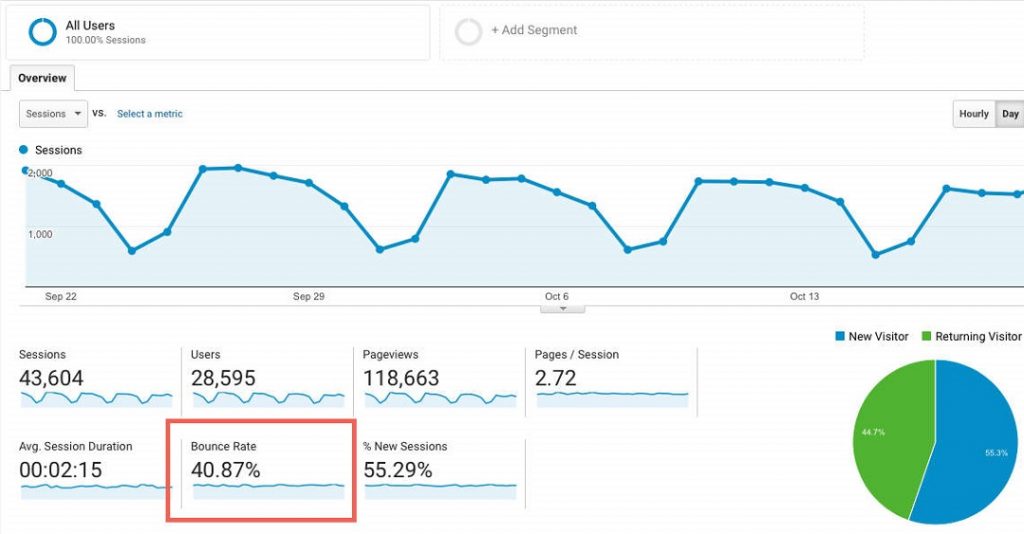

On Google Analytics, one of the conspicuous statistics is the Bounce Rate. The rate is expressed in percentage and serves as an indicator of how people perceive your content. When this percentage is high, it is not a good indicator, and it is then important you know how to fix bounce rate on your website (or blog).
This post would give the tips on how to reduce bounce rate on your website. However, before we do that, it would be good you know the meaning of bounce rate, what a good or a bad bounce rate is.
What is Bounce Rate?
Bounce Rate is a measurement of the percent of people that visit your website and leave immediately, after viewing only one page. The rate is expressed from 0 – 100%, but no matter how awesome your contents are, you can’t have 0%; at the same time, no matter how awful your contents are, you can’t get 100%.
What Is a Good Bounce Rate?
People usually ask what a good bounce rate is. There is no direct answer to that, but if a website’s bounce rate is 40% and below, it is believed that the website is doing fine; if the bounce rate is between 50 – 60%, it is neither good nor bad. However, at 80% bounce rate, the owner of the website should be worried – and learn how to reduce bounce on his or her website.
With the following tips, you should be able to achieve the 40% and below bounce rate mark in months if your current bounce rate is high.
How to Fix Bounce Rate on Websites and Blogs
- Make your website (or blog) mobile responsive
It is no more news that larger percentage of the internet users use their phone and tablets to access websites and blogs. Moreover, there is a high possibility that you are reading this piece from your phone. This shows that if you want to fix bounce rate on your website or blog, you have to make it responsive to all devices.
Nobody wants to visit a website and start scrolling left and right to see your hidden web contents because he or she is using a device with a smaller screen. Therefore, to make people spend more time on your website and make them view many pages, make your website responsive to all screens and devices.
- Make your website load faster
A web page that takes more than 30 seconds to load its main elements is a big turnoff. Moreover, since the attention span of we humans has drastically reduced in recent time, the only way to keep people engaged to your content and prevent them from bouncing off is by making sure your website is super fast.
To make your website’s loading faster, resize and compress your images before uploading them, install image compressing and caching plugins, use a lightweight theme, and minify your codes. You may want to consider changing your host if you carry out a speed test for your website and the result indicates that web host’s response rate is low.
- Provide helpful contents
People visit websites and blogs because of their needs, which could be news, or research, or because they want to find out more about a product or service. So, what you can do best with your website is to provide people with helpful contents that meet their needs – without wasting their time.
If you are serious about reducing bounce rate on your website, you should make your web contents informative, helpful, and well-written. You should also apply proper formatting, spacing, headlines, bullet points, and give room to lots of white space around your content.
- Write attention-grabbing headline and introduction
As stated in the last point on how to fix bounce rate on your website, it is awesome to provide helpful contents. However, if your helpful contents don’t have captivating headlines (that compels people to click) and introductory paragraphs (that grab their attention), visitors would still bounce off your website.
Therefore, learning how to write attention-grabbing headlines and making your introductory paragraphs captivating would make people spend more time on your website.
- Be wary of pop-ups and ads
Pop-ups and ads are not necessarily bad. You use pop-ups to build your email list and call people to action; you need ads to earn income from your blogs. Nevertheless, when pop-ups and ads are too much and irrelevant, you are likely to turn off your website’s visitors and make them leave.
For this reason, to fix bounce rate on your website, you should consider reducing the pop-ups and ads on your pages – if they are too much. Reducing them would allow your contents have more space to breath, and your readers would be able to go through your contents with less distraction.
- Interlink content where relevant
Interlinking is a way of referring your readers to other relevant pages on your website. When writing content for your website or blog, try as much as possible to interlink to relevant, helpful posts. Doing it helps increase pageviews, reduce bounce rate – and add value to your SEO.
- Take caution with external links
External links make your contents appear to be authentic, especially if you are linking to authority websites. The only problem with external links is that if the links are overriding your webpage when clicked on, they would negatively impact your website’s bounce rate.
Therefore, to reduce bounce rate on your website, endeavour to make external links open in a new tab or window when clicked on. Doing this would ensure both your webpage and the external page are open at the same time and prevent visitors from exiting your page.
- Deploy interactive sidebar
Interactive sidebars are effective in reducing bounce rate on a blog; with sidebars, you can have sections for popular posts, recent posts, categories, popular tags, and more. When web visitors see sidebars listing the sections, they are tempted to click, and that increases your pageview, which in turn reduces bounce rate.
- Redirect 404 error page
Due to broken links, deleted post, and other factors, your website or blog might have 404 error pages. When visitors land on the pages, they immediately move away, and that increases the bounce rate of your website.
To fix bounce rate on your website or blog due to 404 error pages, redirect the pages to the appropriate pages. If there is no appropriate page, redirect the visitors to your website homepage. The Redirection Plug-in comes in handy in helping you do the redirecting if your CMS is WordPress.
- Install YARPP
YARPP is popular WordPress plugin that helps to fix bounce rate on websites and blogs. YARPP stands for Yet Another Related Post Plugin, and what it does is to display pages and posts related to web visitors’ current entry, thereby introducing them to other relevant contents on your website.
With the plugin, your web visitors could spend lots of time on your website, reading pages upon pages, and that helps in drastically reducing the bounce rate of your website.
Now you know how to fix bounce rate on your website or blog. Apply the tips shared in this post, and come back to share with us how it has helped you to take down the high bounce rate plaguing your website or blog.
Join our list
Subscribe to our mailing list and get interesting stuff and updates to your email inbox.

